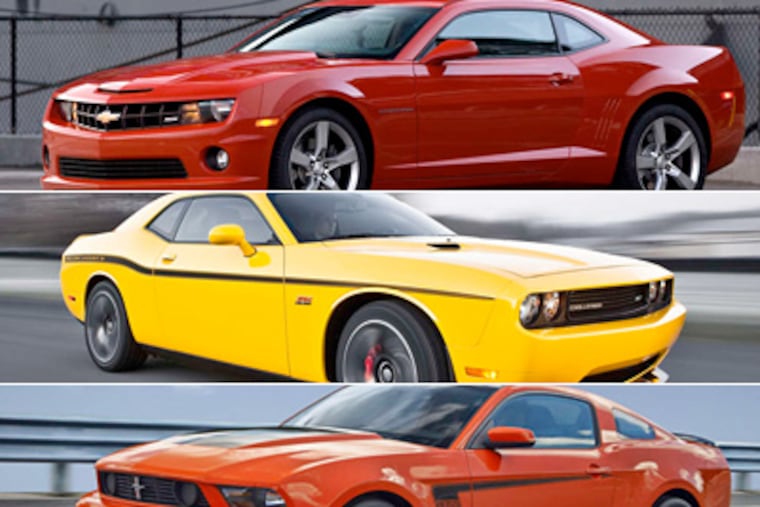Driver's Seat: Muscle cars face off over the road
2012 Camaro 2SS Coupe vs. 2012 Dodge Challenger SRT8 392 vs. 2012 Ford Mustang Boss 302: Part 2: A Driver's Seat muscle-off.

2012 Camaro 2SS Coupe vs. 2012 Dodge Challenger SRT8 392 vs. 2012 Ford Mustang Boss 302: Part 2: A Driver's Seat muscle-off.
Vital statistics: In this corner, weighing in at 3,849 pounds, is the Camaro SS, with a 6.2-liter V8 producing 426 horsepower and 420 foot-pounds of torque.
The tubby 4,160-pound Challenger with a 6.4-liter Hemi V8 produces a whopping 470 horsepower and 470 foot-pounds of torque.
Last but not least, weighing in at a svelte 3,682 pounds, the Mustang Boss 302 boasts a comparatively tiny 5.0-liter V8 producing 444 horsepower and 380 foot-pounds of torque.
On Sunday, I gave readers a feel for sitting in the car the first time. Today I'll take them for a spin.
Sounds of speed: Upon start-up, all three cars let drivers know they mean business. Turn the key and the rumble of the engine and the exhaust spring to life.
If you like subtle, the Hemi in the Challenger is your thing. Even revved up on hills, it's never a piercing scream.
If you want everyone to know you're coming, buy the Mustang. The whole car shakes from the rumble of the engine. My inner 11-year-old enjoyed putting it into neutral in tunnels and revving the engine.
The Camaro falls somewhere in the middle.
Shifting: The Camaro's six-speed stick gives new meaning to the term muscle car. The first time
I pushed in the clutch it pushed back, hard. But I warmed to it after a couple of drives, although the pleasant leather-wrapped shifter does involve throws both long and truck-like.
If you are silly enough to pay a thousand bucks extra for a Challenger with an automatic, buy a Cadillac or something like it. You can flip through the gears by pushing the lever side to side, an unrewarding feature. Zzzzz.
The Mustang shifter is a delight. Not only is it an adorable ball, but the throws are close and the shifter easy to move.
Impress friends and family: Sturgis Kid 4.0, at age 11, is my outer 11-year-old, and he is definitely the focus group for these vehicles. We had a blast as I plastered him in the seat getting up to highway speeds.
Really, all three cars are fast, too fast for the real world. Cruising at 70 is a stroll for any of them.
The Camaro was challenging but did give me some sense of control. Still, it was large and bulky, and visibility-limited.
Without the ability to change my own gears, I felt as if I never got the Challenger to live up to its full potential. Controlling a full-out racing start was difficult.
Really, the Mustang was the only one that made me feel comfortable enough to unleash all its available power. And that's a lot of power. Flooring it is just asinine; get it going a little first, and then floor it.
And carry their stuff: The Camaro sacrifices cubby space for added gauges: The oil pressure, battery, oil temperature, and transmission temperature displays all reside in front of the shifter. It's the worst of all worlds, because they range from difficult to impossible to read down there.
The Challenger and Mustang both have lots of cubbies for little items, like phone and whatnot, and tell you everything that's going on, including things like G-force indicators and quarter-mile times.
Staying comfortable: The Challenger's heater is all over the place. It would start out hot but eventually get cold. A neighbor echoed that complaint about his Chrysler 300.
The Camaro and the Mustang both stay comfortable. The Mustang gets a special shout-out, because the heater controls are well done, with a toggle for defrost/face/feet that's easy to follow.
Jamming: For these prices, you'd think the standard radio would be great.
But the old-fashioned Mustang stereo has enough confusing buttons to make you long for the much-maligned Sync.
And sound quality was extremely poor. But who cares when the exhaust note is just a symphony of cylinders?
Feeding the beasts: The Camaro and Challenger tied at 18 m.p.g. in a lot of fast driving.
The Mustang was just a tick higher at 19.
In the end: I'd call the Camaro best suited for wide boulevards and highways. It's the automotive equivalent of a Bruce Springsteen song. If you like the looks, then it's the car for you, and the bargain of the three.
The Challenger is for someone who wants to relive the best of the 1970s. It's big but in a pleasant sort of way.
But if I had my choice, based on driving pleasure and looks, it's Mustang Boss 302 all the way.